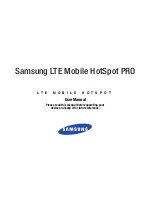
67
●
IP Type
— The type of service provided over a network.
●
IP address
— Internet Protocol address. The address of a device attached to an IP network (TCP/IP
network).
●
ISP
— Internet Service Provider. Also referred to as the service carrier, an ISP provides Internet
connection service. (
See
Network Operator)
●
LAN
— Local Area Network. A type of network that lets a group of computers, all in close proximity
(such as inside an office building), communicate with one another. It does not use common carrier
circuits though it can have gateways or bridges to other public or private networks.
●
MAC Address
— Media Access Control. A number that uniquely identifies each network hardware
device. MAC addresses are 12-digit hexadecimal numbers. This is also known as the physical or
hardware address.
●
Mbps
— Megabits per second. The rate of data flow.
●
MSID
— Mobile Station IDentifier. A number for a mobile phone that identifies that phone to the
network. These numbers are carrier specific.
●
Network Operator
— The vendor who provides your wireless access. Known by different names in
different regions, some examples are: wireless provider, network provider, and service provider.
●
Network Technology
— The technology on which a particular network provider’ s system is built; such
as
LTE
.
●
Port
— A virtual data connection used by programs to exchange data. It is the endpoint in a logical
connection. The port is specified by the port number.
●
Port Forwarding
— A process that allows remote devices to connect to a specific computer within a
private LAN.
●
Port Number
— A 16-bit number used by the TCP and UDP protocols to direct traffic on a TCP/IP
host. Certain port numbers are standard for common applications.
●
PRL
— Preferred Roaming List. A list that your wireless phone or device uses to determine which
networks to connect with when you are roaming. (Network operator specific).
●
Protocol
— A standard that enables connection, communication, and data transfer between
computing endpoints.
●
Proxy
— A firewall mechanism that replaces the IP address of a host on the internal (protected)
network with its own IP address for all traffic passing through it.
●
Router
— A device that directs traffic from one network to another.
●
SIM
— Subscriber Identification Module. Found in LTE network technology, the SIM is a card
containing identification information for the subscriber and their account. The SIM card can be moved
to different devices.
●
SSID
— Service Set IDentifier. The name assigned to a Wi-Fi network.
●
TCP/IP
— Transmission Control Protocol/Internet Protocol. The set of communications protocols
used
for the Internet and other similar networks.


































